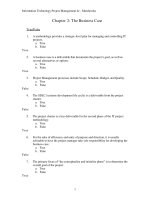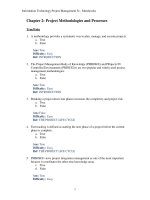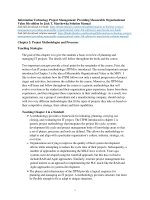Lecture Information technology project management - Chapter 8: Project human resource management
Bạn đang xem bản rút gọn của tài liệu. Xem và tải ngay bản đầy đủ của tài liệu tại đây (311.67 KB, 37 trang )
Chapter 8:
Project Human Resource
Management
adopted from PMI’s PMBOK 2000 and
Textbook : Information Technology Project Management
1
Contents
• Importance of Human Resource Management
• Project human resource management processes
– Organizational planning
– Staff acquisition
– Team development
• Keys to Managing People
– motivation: Hierarchy of Needs (Maslow), Motivational and
Hygiene Factors (Herzberg), Theory X and Y (McGregor)
– succeed factors and fail factors
– influence and power: types of power
– effectiveness: 7 habits for highly effective persons
• Organizational Planning
• using software to assist in HRM
2
The Importance of Human
Resource Management
• People determine the success and failure of
organizations and projects
• Despite the downturn in the economy in 2001,
there is still a shortage of good IT workers
– ITAA calculated that there were over 844,000 openings
for IT jobs in 2000
– 1 in 14 American workers are involved in IT jobs
– Although women represent 47 percent of the work
force, they make up only 29 percent of IT jobs
Chapter 8
3
What is Project Human
Resource Management?
• Project human resource management
includes the processes required to make the
most effective use of the people involved
with a project.
• Processes include
– Organizational planning <= planning phase
– Staff acquisition
<= planning phase
– Team development
<= execution phase
Chapter 8
4
Keys to Managing People
• Psychologists and management theorists have
devoted much research and thought to the field of
managing people at work
• Important areas related to HR management
include
– motivation theory
• Marlow, Herzberg and McGregor
– influence and power
– effectiveness of manager
• Stephen Covey
Chapter 8
5
Maslow’s Hierarchy of Needs
• Abraham Maslow developed a hierarchy of needs
to illustrate his theory that people’s behaviors are
guided by a sequence of needs
• Maslow argued that humans possess unique
qualities that enable them to make independent
choices, thus giving them control of their destiny
• Human needed to be satisfied starting from the
lowest level and move upward
6
Maslow’s Hierarchy of Needs
Chapter 8
7
Herzberg’s Motivational and
Hygiene Factors
• Frederick Herzberg wrote several famous books
and articles about worker motivation. He
distinguished between
– motivational factors: achievement, recognition, the
work itself, responsibility, advancement, and growth,
which produce job satisfaction
– hygiene factors: cause dissatisfaction if not present,
but do not motivate workers to do more. Examples
include larger salaries, more supervision, and a more
attractive work environment
Chapter 8
8
McGregor’s Theory X and Y
• Douglas McGregor popularized the human relations
approach to management in the 1960s
• Theory X
– assumes workers dislike and avoid work, so managers must use
coercion, threats and various control schemes to get workers to
meet objectives
• Theory Y
– assumes individuals consider work as natural as play or rest and
enjoy the satisfaction of esteem and selfactualization needs
• Usually, many managers use of mixture of these theories to
their daytoday work to motivate team members
• Theory Z
– introduced in 1981 by William Ouchi and is based on the Japanese
approach to motivating workers, emphasizing trust, quality,
Chapter 8
9
collective decision making, and cultural values
Improving Effectiveness
Covey’s 7 Habits
• Project managers can apply Covey’s 7
habits to improve team effectiveness on
projects
–
–
–
–
–
–
Be proactive
Begin with the end in mind
Put first things first
Think win/win
Synergize
Seek first to understand, then to be
understood
– Sharpen the saw
Chapter 8
intrapersonal
skill
interpersonal
skill
10
Organizational Planning
• 12th of 21 planning phase process
• It involves identifying, documenting, and
assigning project roles, responsibilities, and
reporting relationships
– The assignment can be internal or they may come from
outside.
– Internal groups are usually composed of specific
functional departments, such as IT, engineering,
marketing, or account.
– HR is an important area because people are the
project’s most valuable resource.
Chapter 8
11
Inputs to Organizational
Planning
• Project interfaces
– organizational interfaces – formal and information report
relationships among different organizational units; Technical
interfaces: formal and informal reporting relationships among
technical disciplines; formal and information reporting
relationship among different individual working on the project
• Staffing requirements
– define skills required of individuals or groups and the desired
time frame within which they’ll be needed.
• Constraints
– factors such as organizational structure, collective bargaining
agreements with unions or other employee group, preferences of
the project team, expected staff assignments.
12
Tools and techniques
• Templates
– help to define roles and responsibilities or reporting
relationships
• HR practices
– help to plan the structure of project team
• Organizational theory
– help to structure the organization (see other
descriptions)
• Stakeholder analysis
– help to ensure stakeholders’ needs and expectations
are met.
13
Outputs from Organizational
Planning
• Role and responsibility assignments
– assignment of roles and responsibilities
• Staffing management plan
– describe when and how HR will join and leave the project team.
– Resource histograms that show resource requirements, their
usage, and availability along a timeline are often incorporated
into the staff management plan. It is part of the project plan.
• Organization chart
– displays the reporting relationships in a graphic format.
• Supporting details
– includes organizational impact, job descriptions, training needs.
14
Staff acquisition
• 13th of 21 planning phase process
• It involves getting the people resources needed
assigned to and working on the project.
• The project manager doesn’t not always have
direct control over these resources because many
of them will be assigned to the project team by
other managers
15
Staff acquisition
• Staffing plans and good hiring procedures are important
in staff acquisition, as are incentives for recruiting and
retention
– Some companies give their employees one dollar for every hour
a new person they helped hire works
– Some organizations allow people to work from home as an
incentive
– Research shows that people leave their jobs because they don’t
make a difference, don’t get proper recognition, aren’t learning
anything new, don’t like their coworkers, and want to earn more
money
16
Inputs to Staff acquisition
• Staff management plan
– describe when and how HR will join and leave the project team.
Resource histograms that show resource requirements, their
usage, and availability along a timeline are often incorporated
into the staff management plan. It is part of the project plan. It is
the main Organizational planning output.
• Staffingpool description
– includes the characteristics of potential staff, their experience,
interests, characteristics, and availability.
• Recruitment practices
– include various organizational policies, guidelines, and
procedures governing staff assignment. These are a constraint on
staffing.
17
Tools and techniques
• Negotiations
– ensure that there are appropriate resources at the
required time. It is the role of project manager
negotiate with functional managers or others (e.g.
other project managers)
• Preassignment
– in some cases, staff were promised the assignment
before the project started. It is an internal practice in
many organizations.
• Procurement
– recruiting people outside the organization. This
technique entails hiring consultants and contractors
18
Outputs from Staff acquisition
• Project staff assignments
– indicate who will work on the project full
time, parttime, or variably.
• Project team directory
– lists all project team members and key
stakeholders. It can be a simple, informal list
or very detailed.
19
Sample Organizational Chart for a
Large IT Project
Chapter 8
20
Resource Loading and Leveling
• Resource loading
– refers to the amount of individual resources an existing project
schedule requires during specific time periods
– Resource histograms show resource loading
– Overallocation means more resources than are available are
assigned to perform work at a given time
• Resource leveling
– a technique for resolving resource conflicts by delaying tasks
– The main purpose of resource leveling is to create a smoother
distribution of resource usage and reduce overallocation
Chapter 8
21
Sample Resource Histogram for
a Large IT Project
22
Resource Leveling Example
23
Team Development
• 3rd of 7 executing phase process
• The project manager must enhance the team to function
as a coordinated unit
– it takes teamwork to successfully complete most projects
– This is critical on uncertain projects, such as risky research and
development (R&D) project
• It is necessary to develop each person in both managerial
and technical areas.
– Training can help people understand themselves, each other, and
how to work better in teams
• Team building activities include
– physical challenges
– psychological preference indicator tools
Chapter 8
24
Inputs to Team Development
•
Project staff
– It is an output of Staff Acquisition process, where it is project staff assigned.
– The key is that particular skill sets for individuals and the team are available
to support the project.
•
Project plan
– incorporates the integrated documents that provide the baseline for
controlling changes.
•
Staffing management plan
– It is the main Organizational planning output
•
Performance reports
– alert the project team to issues that can cause problems in the future. Status
reports describe the project’s current standings. Progress reports describe the
team’s accomplishments.
•
External feedback
– criticism from outside the project helps the project team make periodic
measures of performance.
25









